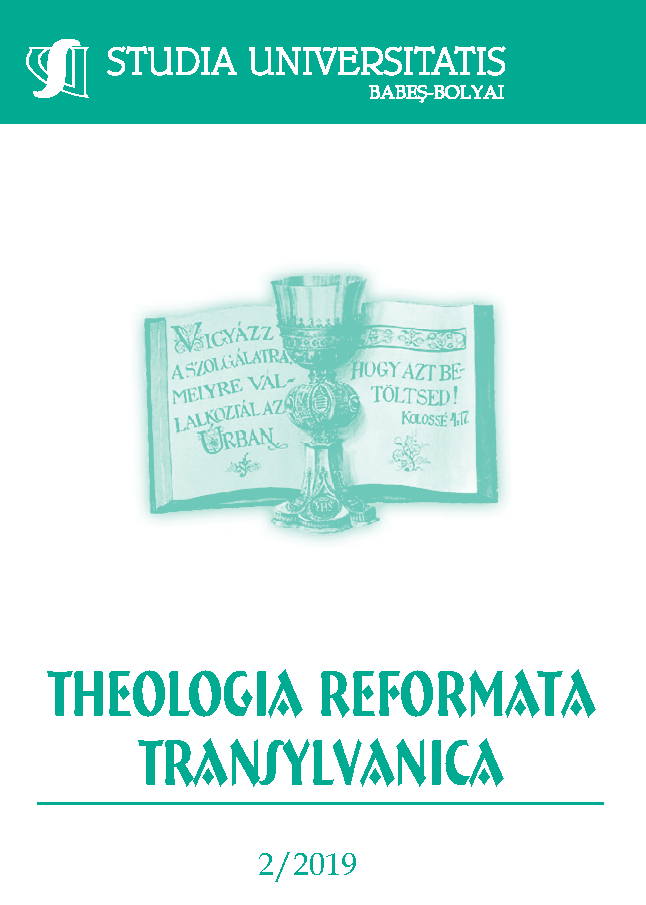„Gyermek születék Betlemben.” Egy középkori kanció az oltszakadáti evangélikusok hagyományában
DOI:
https://doi.org/10.24193/subbtref.64.2.09Keywords:
cantio, Gradual, popular variant, Puer natus singing, tower-song, polyphonic choir, liturgy.Abstract
Child is Born in Bethlehem. A Medieval cantio in the Tradition of the Lutherans in Oltszakadát (Săcădate).
Several Hungarian-speaking Transylvanian Lutheran congregations of the 20th century have sung Gregorian passions together with a number of liturgical songs belonging to the Holy Week (such as Kyrie puerorum, Lamentatio Mariae). The Lutheran congregation in Oltszakadát is the only Lutheran congregation in Transylvania, that owns an exemplar of the so-called Öreg Graduál, the Protestant book of devotion that includes these items. The handwritten notes in the Gradual from Oltszakadát, as well as the corrections done by hand in the case of worn-out pages that contained often-sung liturgical hymns, all emphasize the fact of the Gradual’s actual regular use. The congregation in Oltszakadát kept till this day the specific singing practice of Puer natus set in the old hymnals and graduals. The local Hungarian version of the medieval cantio starting with the words Puer natus in Betlehem in hoc novo anno, is sung by the congregation on Christmas Eve’s service, and is repeated in the tower-song subsequent to the church service. The local Hungarian version, starting with Gyermek születék Betlemben ez új esztendőben is actually a variant of the cantio with the same name present in the Gradual from Eperjes (Eperjesi Graduál). The practice of Puer natus singing is still alive in Transylvanian Saxon-Lutheran congregations, and some congregations have recently readopted it. Whether it be due to the Saxon influence or the close relationship to the Gradual from Eperjes, the congregants from Oltszakadát sing the song in simple polyphony.
References
BENKŐ Timea: A kiskapusi passió. In: Református Szemle, 98. évf., 2005. 1. szám. 39–69.
BLÖCHL, Arnold: Melodiarium zum Wilhelm Paillers Weihnachts- und Krippenlieder-sammlung herasugegeben in den Jahren 1881 und 1883. Corpus Misicae Popularis Austriacae 13/1. Volksmusik in Oberoesterreich, Böhlau Verlag, Wien–Köln–Weimar, 2000.
BLUME, Clemens: Repertorium repertorii. Kritischer Wegweiser durch Ulysse Chevaliers Repertorium Hymnologicum. Georg Olms Verlag, Hildesheim–New York, 1971.
DOBSZAY László: A magyar népének I. Egyházzenei Füzetek I/15, I. sorozat: Tankönyvek, MTA–Liszt Ferenc Zeneművészeti Egyetem Egyházzenei Kutatócsoportja és A Magyar Egyházzenei Társaság, Budapest, 2006. 202. szám. 66.
Ethnographische Sammlung. Siebenbürgisch-Sächsische Bräuche und Traditionen – Wei-hnachten. http://traditionen.evang.ro/fe/tradition/view/19 (Utolsó megtekin-tés: 2019. szeptember 5.).
Gyermek születék – Karácsony Oltszakadáton. In: Az én időm, mint a szép nyár. A magyar nép istenes énekei. CD kiadás. A hangfelvétel a CREATON stúdióban ké-szült, 2000-ben. 1. felvétel.
JAKABFFY Tamás: Passió és Mária-siralom Kiskapuson. In: Helikon. Irodalmi portál, 30. évf., 2019. 8. (766. szám). https://www.helikon.ro/passio-es-maria-siralom-kiskapuson/ (Utolsó megtekintés: 2019. augusztus 25.)
KURTA József: Az Öreg Graduál századai Erdélyben (Erdélyi Református Egyháztörté-neti Füzetek 8.). Kolozsvár, 2002.
MELTZER, Angelika – CHRESTELS, Rozemarie: E Liedchen hälft ängden. Alte und neue Lieder aus Siebenbürgen. Haus der Heimat V., Nürnberg, 2017, 2018. MP3 formában meghallgatható itt: https://www.angelika-meltzer.de/alte-und-neue-lieder-aus-siebenb%C3%BCrgen/. (Utolsó megtekintés: 2019. szeptember 5.)
PAPP Géza: A XVII. század dallamai. Régi Magyar Dallamok Tára (RMDT) II., Akadémiai Kiadó, Budapest, 1970.
PELGER, Matthias: Weihnachten. Aus dem almer Heimatbuch. https://alma-vii.de/phpalmen/modules.php?name=Sections&artid=47 (Utolsó megtekintés: 2019. szeptem-ber 5.)
SÁNDOR Andrásné: Egyházi népszokások az oltszakadáti magyar evangélikusoknál. In: FEJŐS Zoltán – KÜLLŐS Imola (szerk.): Vallásosság és népi kultúra a határainkon túl. Magyarságkutató Intézet, Budapest, 1990. 193–196.
SCHENKER, Ursula: „Puer natus” erfreut sich großer Beliebtheit. http://www.drabenderhoehe.de/2017/12/30/puer-natus-erfreut-sich-grosser-beliebtheit/ (Utolsó mgtekintés: 2019. szeptember 5.)
Siebenbürgen.de. Portal der Verband der Siebenbürgen Sachsen. Ein Kind geborn zu Bethlehem in diesem neuen Jahr. Quelle: Heimatbuch Petersdorf/Unterwald. https://www.siebenbuerger.de/ortschaften/petersdorf-muehlbach/erzaehlung/46771-puer-natus.html. (Utolsó megtekintés: 2019. szeptember 5.)
STROHM, Reinhard: Das geistliche Lied des 14. und 15. Jahrhunderts. https://musical-life.net/essays/das-geistliche-lied-des-14-und-15-jahrhunderts (Utolsó megte-kintés: 2019. szeptember 5.)
VÁMSZER Géza: Szakadát. Egy szebenmegyei magyar szórvány. Erdélyi Enciklopédia Kiadás, Kolozsvár, 1940.
Downloads
Published
How to Cite
Issue
Section
License
Copyright (c) 2019 Studia Universitatis Babeș-Bolyai Theologia Reformata Transylvanica

This work is licensed under a Creative Commons Attribution-NonCommercial-NoDerivatives 4.0 International License.






